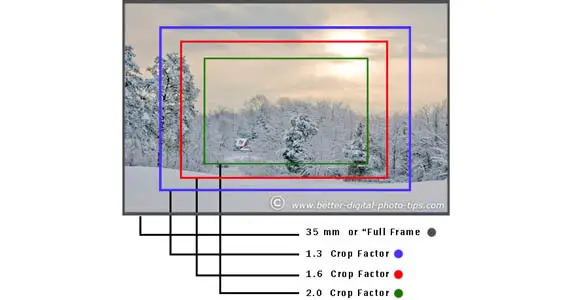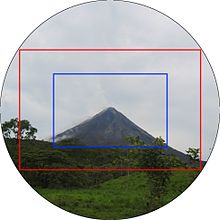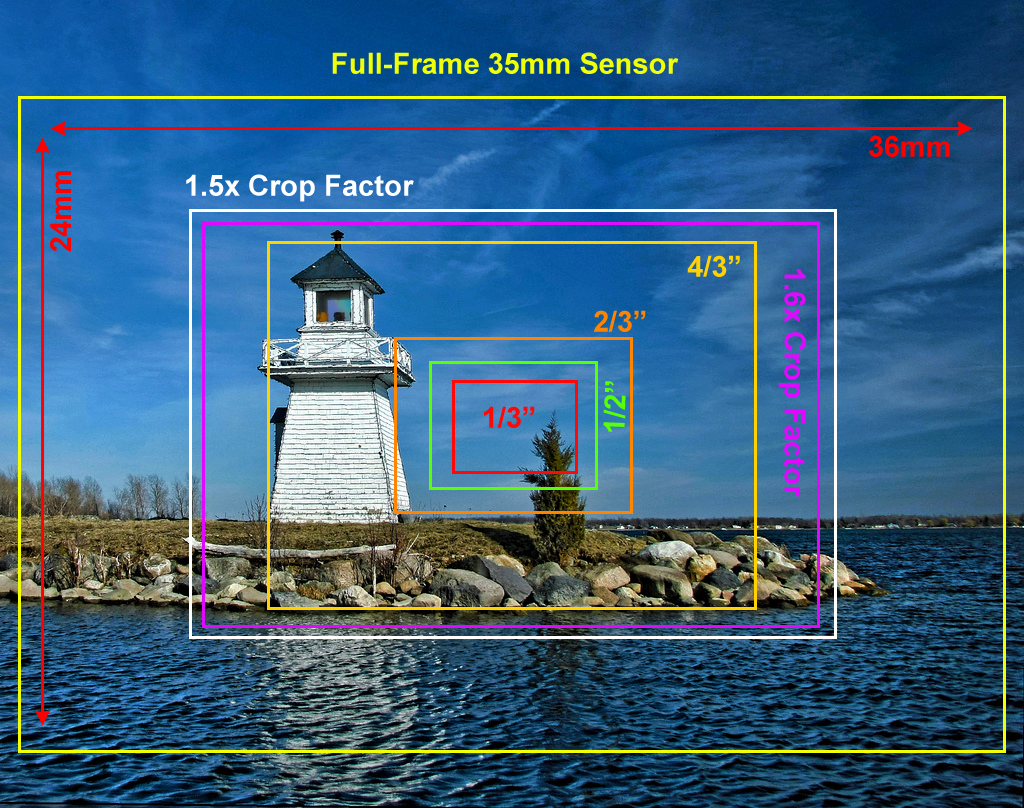Crop factor
The form factor is a term used in photography. It specifies the length ratio between the diagonals of two recording formats ( areal image size).
Application
Since recording format picture angle and focal length are related via the optical theorem, the form factor can be used to calculate what focal length a lens would have to point to a different recording format ( image size) at the same distance to the subject ( object size ) the same image.
With digital SLR cameras that are based on small -screen predecessors, the small picture format of 24 mm × 36 mm was used as a comparative format. The diagonal of the light-sensitive surface of the image sensor multiplied by the form factor here gives the diagonal of the small screen format. The diagonal of the recording format is by definition equal to the normal focal length for this recording format ( see also normal lens ). With a form factor of 1.5 (based on the small picture format ) the normal focal length is 43 mm / 1.5 = 29 mm.
The same phenomenon occurs in the transition from large and medium - size to miniature cameras. Instead of specifying the form factor, we classified usefully Camera Lenses based on their angle for the particular size as a wide -angle, normal or telephoto lens (the telephoto design alone does not affect the angle of view, but often lenses with a low angle of view and long focal length telephoto designs are ).
Alternate terms
The following terms are used in connection with the phenomenon of angle change for the same focal length but different image size interchangeably.
Crop Factor
A reduction of the light-sensitive surface causes a cropping of the image field ( decreasing the angle of view ). The form factor is also called crop factor (of English. = Crop to crop ). A reduction of the recording format is equivalent to a detail enlargement.
" Focal length extension factor "
The term " crop factor " is used synonymously with form factor, although it is misleading. The focal length of a lens is determined by its design and can not be changed by reducing the recording format. By changing the recording format merely changes the angle of view.
KB - equivalent focal length
The term small picture format equivalent focal length is determined based on the product of the actual focal length and the form factor to the small format. It refers to the focal length, the same angle of view gives the small picture format as the actual focal length of a lens at each recording format.
This concept also is misleading, since the equivalence applies only to the picture angle. For example, the course of the depth of field, the critical orifice, the achievable cooling power at the image sensor, the adjustment paths of the lens motors or the impact of the focusing error and many other aberrations not from the angle of view, but from the size of the image sensor surface are dependent.
Angle factor
The occasionally encountered term angle factor is an attempt to take account of the fact that it is not the focal length that varies with the recording format, but the used angle. However, it is often wrongly assumed, format and image angle factor are identical. This is not so: When varying the focal length of the effective angle of view of a lens changes (see also zoom factor ) even when modified Recording format varies. That is, the transition from a film camera to a digital camera with a smaller sensor, the picture angle used a 20 mm wide- angle lens changes, for example, less than about that of a 400 - mm telephoto lens. Therefore, caused by the transition to a recording format change of the used image angle can not be described by a valid factor for all focal lengths. The cause lies in the relationship between recording format, focal length and angle of the non-linear tangent function.
Example
The image sensor of many popular digital SLR cameras is by a factor 1.5 to 1.6 smaller than the usual small format (24 mm × 36 mm), eg 15.7 mm × 23.5 mm (so-called APS -C format). With a lens with 50 mm focal length lens "sees" the image sensor only a part of what the miniature film " saw ". Comparing 9 - × 13- cm prints of photos that were shot on a small screen and a standard digital camera with this lens, so it acts as though the image from the digital camera came with a longer focal length. If you want to achieve the same detail as with the digital camera with the small camera, so 50 mm × 1.6 has a longer focal length to the size factor, in this case = 80 mm, used, or an appropriate enlarged can be made.
Other values , such as the depth of field, also change the form factor or its reciprocal value when recording with the same lens, but changed the recording format. Thus, the transition from small screen to a smaller image sensor, the depth of field is reduced to the form factor with the same focal length. However, on the same image, that is, with correspondingly shorter focal length, the depth of field increases in proportion to the size factor.
Format factors common sensor sizes relative to the small format
Summary
Change the recording format ( eg with a smaller sensor or through the establishment of an enlarged when connecting a lens for a small SLR camera to a digital SLR ), then:










